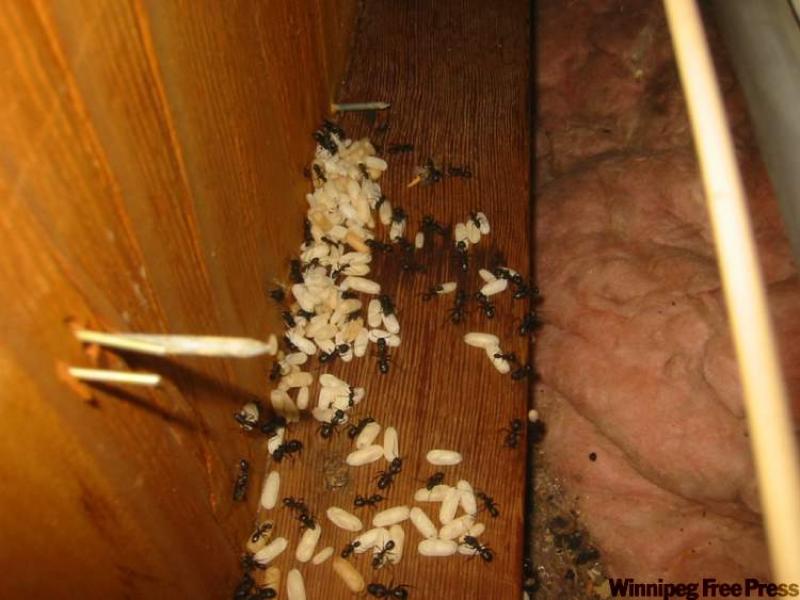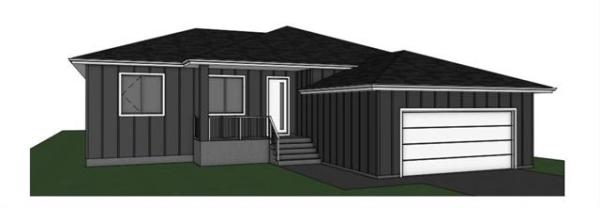QUESTION: I am hopeful you can help me find a solution for what I believe are carpenter ants in my home.
Over the last while, we have discovered the odd large ant in various areas of our home. A couple of days ago, there was green-grey fuzz on the floor by the interior wall near the front door. Upon removing the baseboard, I found about five large ants. We used the vacuum cleaner to clean up the ants and fuzz. The other day, I checked the same vicinity in the attic, but couldn't see any ants on top of the insulation. In a corner above the front door, along the insulation barrier on the outer wall, there was a cream or pale yellow-coloured sphere, about two inches in diameter. The ceiling in that area is vaulted, so I was unable to get close enough for a better inspection. Would you have an idea what it might be? I have been unable to find pictures of a carpenter ant nest.
What suggestions can you suggest to get rid of the ants from our home?
Thank you for considering my problem.
-- Fred Nicholson, Winnipeg
ANSWER: This time of year is ideal for many household pests to gain entry into our living areas due to the warm, wet weather we have been experiencing. Many types of insects, birds and rodents will look for refuge from the elements either on the outside or inside of various areas in our homes. They will often build nests that provide a location for reproduction or comfort during the upcoming colder weather. Many of these areas of refuge have one thing in common: they have become damaged by moisture or deterioration to provide easy access.
Carpenter ants, unlike termites, don't actually ingest wood or destroy dry, solid material. They can, however, create quite a bit of damage from excavation of rotting wood framing and other components while building tunnels for movement and nesting. These tunnels can become quite intricate and lengthy and reduce the strength of existing walls to the point of needing replacement.
Once the ants have established a substantial presence inside the walls of your home, the actual nest can be the wall framing itself. They can lay eggs that will incubate inside the walls and produce even more ants upon maturing. Often, the only way to get rid of them is to remove the damaged components.
The first hint that you may have a serious infestation of carpenter ants is the "fuzz" that you have spotted near the wall. That material is a sawdust-like substance that is produced by the ants after chewing their way through the damaged wooden components. It may be from the wooden baseboards and trim or from the studs in the exterior wall itself. Since you have removed the baseboards, If you see more of that appear it's more evidence of nesting bugs in your walls.
The next thing to do is determine where they are getting into your house. There is a chance that the ants have gained access to your home through the attic, from damaged eaves or small openings in that area, but there are more likely culprits. I'm not sure what the round yellow thing in your attic is, but it may or may not have anything to do with the ant infestation. It could be some blown-in foam insulation that has seeped into this area from installation of the front door. If your door has been recently changed, that's the likely origin of the mysterious object and nothing to worry about. If your front door is older, or if it has been recently replaced due to deterioration of an older door and frame, that's the most likely caused by the ant intrusion.
Small gaps around doors or windows provide ideal areas for ants to sneak through the otherwise well secured building exterior. If the wooden sills or trim are slightly rotten, it makes it even easier for them to gain access. Even without damaged wood, the ants can take up residence in the void between the door frame and the wall studs and create a breeding colony. If the framing, siding, or interior wall covering the area adjacent to the door is deteriorated, due to years of exposure to wind driven rain or leakage from the door trim, that's ideal access to the wall cavity for the ants. Check all around that area for gaps and seal them with caulking or other sealants to prevent further intrusion.
Unfortunately, once wood has been damaged by carpenter ants, the only way to remedy the situation may be complete removal and replacement of the damaged material. You may want to start with removal of a section of the interior wallcovering and insulation near the floor to inspect the extent of the damage. If there is no visible rot or damage, you may have a small problem that could be solved with a can of bug spray and some caulking. If more extensive damage is seen, removal of the entire wallcovering and insulation in the area may be required to get at the damaged framing for replacement. In the worst cases, portions of the exterior wall sheathing and siding may also have to be cut out to permanently solve the problem.
With most pest intrusions into homes, a small area of access is required to take up residence. This area may be small enough to be invisible until except under much closer scrutiny. Most times, pests prey on wooden or other components that are moisture-damaged. Finding and replacing these rotten components is the key to keeping the critters out of your home, where they belong.
Ari Marantz is the owner of Trained Eye Home Inspection Ltd. and the President of the Canadian Association of Home & Property Inspectors - Manitoba (www.cahpi.mb.ca). Questions can be e-mailed to the address below. Ari can be reached at (204) 291-5358 or check out his website at www.trainedeye.ca.
trainedeye@iname.com




